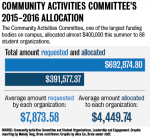Leaders of several student organizations expressed disappointment after receiving less funding than they requested from one of the largest campus funding bodies.
The Community Activities Committee, or CAC, had about $400,000 to allocate to student groups this year. CAC provides funding for student organizations that serve underserved communities. Groups apply each summer to finance events during the upcoming academic year.
The allocation amount this year was only a few thousand dollars lower than last year’s, said Jonathan Tam, chair of the committee and a graduate student in education. He added the amount has been fairly consistent in past years, but he expects it will continue to slowly decline.
Tam said the rising number of new student organizations is the main reason why student groups received less funding. He said this year 88 groups applied, compared to 79 in 2014 and 74 in 2013.
He added the growing amount of student groups applying over the years decreases the amount of surplus money left over to fund next year’s groups.
Tam said two years ago, the committee had $135,000 of surplus. This year, there was only $65,000 carried over.
CAC receives its money from various sources, including a $3.75 student fee, which accounts for about 30 percent of CAC’s budget. The Student Fee Advisory Committee, which is funded by a yearly student fee of around $1,000, provides the rest of the fund.
Tam said CAC eliminated the CAC supplemental fund, which originally allowed student groups to reapply for more funding within the same year, in an attempt to slow the decline in CAC’s funding ability. However, he said the CAC mini fund, which has a lower funding cap and a later deadline but is similar to the CAC supplemental fund, still exists.
Tam added none of the 88 groups that applied this year received their entire requested amounts.
Alex Pham, a finance director of Vietnamese Community Health, or VCH, and a third-year microbiology, immunology and molecular genetics student, said his organization applied for the maximum CAC allocation of $10,000. This year, VCH received about $8,300, around $800 less than last year.
Pham said he thinks the decrease in funds should not be a problem for student groups because group leaders should know the money isn’t supposed to last the entire year.
“We are expected to apply for funds from other sources,” Pham said.
Caren Nicdao, a fourth-year mathematics student and director of programming at the Mentorship Program at UCLA, said her organization applied for about $10,000 but only received $2,200, in contrast to $4,000 received last year.
Nicdao said she thinks the reduction makes it harder for her organization to reach out to the community her club serves.
“With over 120 service recipients, we don’t have sufficient funds to attend to all of their needs,” Nicdao said.
Miguel Sanchez, a fourth-year sociology student and a co-executive director of Amigos de UCLA, said he thinks it’s too early to determine whether the reduction will be problematic.
Sanchez said the organization applied for approximately $10,000 this year but was granted around $8,800. Last year, they received the full $10,000.
Sanchez said Amigos de UCLA usually applies for other sources of funding to help cover the club’s operational costs.
“The money we received covers transportation and not much else,” Sanchez said.
He said he thinks a referendum that raises the student fee to compensate for the lack of funding could be a solution.
Last spring, undergraduate student government councilmembers proposed a Student Groups Events Referendum that would have raised quarterly student fees by $3 to provide more funding for student organizations. The referendum failed with a 46.1 percent vote. It would have added $1.13 to the $3.75 that each students already pays to CAC.
Tam said CAC is trying to encourage student groups to be more responsive to socially and economically underserved communities they serve.
